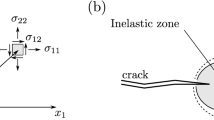Abstract
Accurate computation of stress intensity factors for two-dimensional cracks by a dual interpolation boundary face method (DiBFM) is presented in this paper. Dual interpolation method combines traditional element polynomial interpolation and moving least-squares approximation. Dual interpolation elements are obtained by adding virtual nodes on the boundary of traditional discontinuous elements, and they unify traditional continuous and discontinuous elements. With the dual interpolation elements, both the continuous and discontinuous fields can be approximated, and the accuracy of interpolation increases by two orders compared with the corresponding discontinuous elements. In addition, a new singular element based on the dual interpolation method for modeling displacement fields around the crack tip is proposed in this paper. The stress intensity factors are extracted from the relative displacements between the crack surfaces. Using the DiBFM combined with the proposed singular element, accurate results of the stress intensity factors can be obtained. Numerical examples have demonstrated the accuracy and efficiency of the proposed method.









Similar content being viewed by others
References
Rooke, D.P., Cartwright, D.J.: Compendium of Stress Intensity Factors. Her Majesty’s Stationery Office, London (1976)
Murakami, Y.: Stress Intensity Factors Handbook. Pergamon Press, Oxford (1987)
Brebbia, C.A., Telles, J.C.F., Wrobel, L.C.: Boundary Element Techniques: Theory and Applications in Engineering. Springer, Berlin (1984)
Cisilino, A.: Linear and Nonlinear Crack Growth Using Boundary Elements. WIT Press, Southampton (2000)
Cheng, A.H.D., Cheng, D.T.: Heritage and early history of the boundary element method. Eng. Anal. Bound. Elem. 29, 268–302 (2005)
Sladek, V., Sladek, J., Tanaka, M.: Nonsingular BEM formulations for thin-walled structures and elastostatic crack problems. Acta Mech. 99(1–4), 173–190 (1993)
Xie, G.Z., Zhang, D.H., Meng, F.N., et al.: Calculation of stress intensity factor along the 3D crack front by dual BIE with new crack front elements. Acta Mech. 228(9), 3135–3153 (2017)
Xu, Z., Su, C., Guan, Z.W.: Analysis of multi-crack problems by the spline fictitious boundary element method based on Erdogan fundamental solutions. Acta Mech. 229(8), 3257–3278 (2018)
Guo, Z., Liu, Y.J., Ma, H., et al.: A fast multipole boundary element method for modeling 2-D multiple crack problems with constant elements. Eng. Anal. Bound. Elem. 47, 1–9 (2014)
Liu, Y.J., Xu, N.: Modeling of interface cracks in fiber-reinforced composites with the presence of interphases using the boundary element method. Mech. Mater. 32(12), 769–783 (2000)
Pan, E.: A general boundary element analysis of 2-D linear elastic fracture mechanics. Int. J. Fract. 88(1), 41–59 (1997)
Blandford, G.E., Ingraffea, A.R., Liggett, J.A.: Two-dimensional stress intensity factor computations using the boundary element method. Int. J. Numer. Meth. Eng. 17(3), 387–404 (1981)
Wen, P.H., Fan, T.H.: The discontinuity displacement method applied to three-dimensional co-planar crack problem for any boundary value condition. Eng. Fract. Mech. 48(5), 691–702 (1994)
Ma, H., Guo, Z., Dhanasekar, M., et al.: Efficient solution of multiple cracks in great number using eigen COD boundary integral equations with iteration procedure. Eng. Anal. Bound. Elem. 37(3), 487–500 (2013)
Xie, G.Z., Zhang, J.M., Huang, C., et al.: A direct traction boundary integral equation method for three-dimension crack problems in infinite and finite domains. Comput. Mech. 53(4), 575–586 (2014)
Hong, H.K., Chen, J.T.: Derivations of integral equations of elasticity. J. Eng. Mech. 114(6), 1028–1044 (1988)
Chen, J.T., Hong, H.K.: Review of dual boundary element methods with emphasis on hypersingular integrals and divergent series. Appl. Mech. Rev. 52(1), 17–33 (1999)
Wang, P.B., Yao, Z.H.: Fast multipole DBEM analysis of fatigue crack growth. Comput. Mech. 38(3), 223–233 (2006)
Zhang, J.M., Qin, X.Y., Han, X., et al.: A boundary face method for potential problems in three dimensions. Int. J. Numer. Meth. Eng. 80(3), 320–337 (2009)
Zhang, J.M., Huang, C., Lu, C.J., et al.: Automatic thermal analysis of gravity dams with fast boundary face method. Eng. Anal. Bound. Elem. 41, 111–121 (2014)
Zhou, F.L., Li, Y., Zhang, J.M., et al.: A time step amplification method in boundary face method for transient heat conduction. Int. J. Heat Mass Transf. 84, 671–679 (2015)
Zhang, J.M., Lin, W.C., Dong, Y.Q., et al.: A double-layer interpolation method for implementation of BEM analysis of problems in potential theory. Appl. Math. Model. 51, 250–269 (2017)
Zhang, J.M., Lin, W.C., Dong, Y.Q.: A dual interpolation boundary face method for elasticity problems. Eur. J. Mech. A/Solids 73, 500–511 (2019)
Acknowledgements
This work was supported in part by National Natural Science Foundation of China under Grant Numbers 11602229, 11602082, 11772125 and 11902141, in part by Opening Project of Cooperative Innovation Center for Nuclear Fuel Cycle Technology and Equipment, University of South China under Grant Number 2019KFQ07, in part by Key Scientific and Technological Project of Henan Province under Grant Number 192102210227.
Author information
Authors and Affiliations
Corresponding author
Additional information
Publisher's Note
Springer Nature remains neutral with regard to jurisdictional claims in published maps and institutional affiliations.
Rights and permissions
About this article
Cite this article
Dong, Y., Zhang, J. & Lin, W. Accurate evaluation of stress intensity factors using dual interpolation boundary face method. Acta Mech 231, 733–741 (2020). https://doi.org/10.1007/s00707-019-02573-x
Received:
Revised:
Published:
Issue Date:
DOI: https://doi.org/10.1007/s00707-019-02573-x



